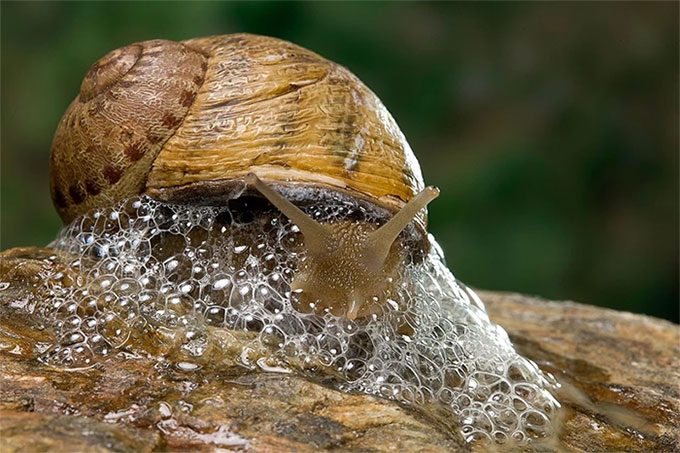Often used for restoring damaged skin, snail mucin has long been utilized as a cosmetic ingredient and has potential applications beyond conventional skincare.
Consumers worldwide are spending money on cosmetic products containing snail mucin, with the global market valued at approximately $555 million in 2022.
After the explosion of snail mucin skincare services in South Korea, this product has been widely shared. However, the use of snail mucin for radiant, healthy skin has been around for a long time.

Snail mucin is used in many skincare products. (Image: Getty Images).
Ancient Greeks used snail mucin for its anti-inflammatory properties. In the 1980s, snail farmers in Chile noted that handling snails for the food market in France resulted in softer hands and quicker healing of cuts.
The Benefits of Snail Mucin for Skin
According to Joshua Zeichner, a dermatologist at Mount Sinai Hospital, the garden snail, the most studied species for skincare, produces mucin that is touted for its moisturizing properties, rich in natural vitamins A and E, antioxidants, and its ability to stimulate collagen production, helping to reduce signs of aging.
According to dermatologist Elizabeth Bahar Houshmand from the American Academy of Dermatology, consumers purchase snail mucin products to restore damaged skin and provide hydration.
Extracts of snail mucin have been shown to create a protective barrier between the skin and polluted air.
One study used a three-dimensional skin model exposed to ozone. The “skin” not protected by snail mucin extract became inflamed and showed signs of aging, resulting in wrinkles and uneven skin tone. The “skin” protected by this extract was less inflamed.
Scientists are also exploring ways to use snail secretions beyond skincare. There is evidence that snail mucin can help heal wounds and treat burns. Snail mucin also possesses antibacterial and antifungal properties.

Snail mucin is rich in natural vitamins beneficial for the skin. (Source: Unsplash).
Another study tested the ability to inhibit bacteria in wounds, and some snail mucins performed better than antibiotics.
Initial research suggests that mucin may also have anti-cancer properties as it successfully inhibited the growth of skin cancer cells in the laboratory.
Scientific Exploration of Snail Mucin’s Potential
To better understand snail mucin, Antonio Cerullo, a biochemist at the City University of New York, collected snails from a farm and analyzed three types of their mucin: protective mucin from the back, sticky mucin from the foot, and lubricating mucin from the foot.
Each type has unique properties, such as viscosity and stickiness, as well as different biochemical components.
In nature, different types of mucin serve various functions, Cerullo explains. The mucin primarily used for lubrication contains more collagen, making it more elastic; the adhesive mucin contains more calcium, making it stickier.
Isolating specific molecules that create these properties and synthesizing them for commercial use is a complex task. Cerullo noted that while the protective mucin of snails contains antibacterial proteins, many molecules within the mucin may interact to produce antibacterial effects on human skin.
Microbiologist Roberta Rizzo and chemist Claudio Trapella at the University of Ferrara in Italy analyzed over 100 different snail mucin products and found quality differences.
The two scientists explained that everything from feeding and nurturing methods in snail farms to how the mucin is harvested affects the final product.
However, snail mucin has potential far beyond skincare, according to Adam Braunschweig, an organic chemist at the City University of New York.
It could be used as a wound healing adhesive for treating ulcers and infections, as well as a natural adhesive in biotechnological applications.

Harvesting snail mucin. (Source: AFP)
Braunschweig stated that snail mucin also works well as a drug delivery vehicle. When used with medication, it enhances the mucous membranes’ absorption of the drug.
Rizzo and Trapelli are also researching snail mucin extracts for producing eye drops in the treatment of dry eye disease.
Commercializing Snail Mucin Products
Scientists have yet to isolate specific components of snail mucin with healing properties, but they can create synthetic versions of mucin, reducing the need for snail farming.
The methods of harvesting snail mucin vary by farm—some allow snails to crawl on a grid to collect dripping mucin into a pan below, while others use misting chambers to stimulate secretion.
However, a large number of snails are needed to meet current demand, and harvesting sufficient snail mucin can be quite costly. The products may also vary daily depending on the type of snail, making their mucin inconsistent.
Braunschweig’s team hopes to produce a synthetic material at a lower cost that can be tailored for specific applications—such as having higher stickiness or more lubrication, depending on the use.


















































